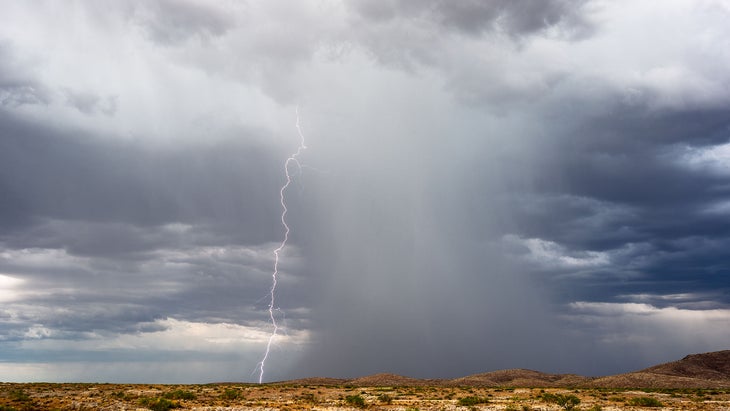Products You May Like
Get full access to Outside Learn, our online education hub featuring in-depth fitness, nutrition, and adventure courses and more than 2,000 instructional videos when you sign up for Outside+
Sign up for Outside+ today.
Read more: The Outdoors’ Most Spectacular Natural Phenomena, Explained
They develop within a few minutes and strike the ground with the force of a runaway freight train. They demolish forests, wreck houses, kill wildlife–and have even been responsible for a half-dozen plane crashes. But for years they were so mysterious that, until 1981, meteorologists didn’t even have a name for them. They are microbursts: turbulent weather conditions that transform a mass of rapidly cooling air into a high-speed downdraft up to 2.5 miles in diameter. Fortunately, most backpackers only observe the aftermath of these violent events. If you ever come across a smashed-up forest with no obvious cause, here’s what might have gone down.
The Basics of Microbursts
Vertical Hurricanes
Microbursts can develop anywhere across the United States; they often appear as wet microbursts in the East and South, and as dry microbursts over the Great Plains, Rocky Mountains, and the Western Plateau. The two types differ dramatically. In the East, microbursts are spawned by large thunderstorms producing heavy rain, lightning, and hail. Their drier, Western counterparts are more subtle, often arising inside small, innocent-looking, cottonball clouds that lack visible precipitation. Swirling dust storms beneath these clouds are sometimes the only clue that downdrafts are occurring.
Dry
In the West, rain often falls from high cumulonimbus clouds into lower, drier air, where it evaporates. This creates virga–misty curtains that hang from cloud bottoms but never reach the ground. Like all liquids, the rain loses heat as it transforms into a vapor. (The same process causes fuel bottles to cool when powering stoves.) This evaporative cooling produces a dense mass of colder air within the cloud.
Wet
In the South and East, heavy rain generated by powerful thunderstorms drags cold, dry air from high in the cloud to lower layers of the storm. As the water and ice suspended in that mass evaporate, the cooling air descends faster through the cloud.

Descent
In both types of microbursts, the cold, dense air mass sinks because it is 20 to 50 percent heavier than the surrounding air. As it descends, it continues to cool and accelerate, eventually plummeting toward the ground at speeds between 15 and 50 mph–and in rare cases up to 150 mph. The entire process can occur in five minutes.
Impact
When the fast-moving air strikes the ground, it acts like a bucket of water poured on a concrete floor, says Steven Vasiloff, formerly a meteorologist at NOAA’s National Severe Storms Laboratory in Norman, Oklahoma. The blast effect and resulting vortexes can flatten trees at the impact site, as well as strip branches and damage vegetation and soil up to several miles away. Unlike tornadoes, which twist and scatter wreckage, microbursts create a radial pattern of destruction, with downed trees and debris oriented outward from the impact zone.
